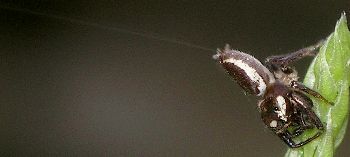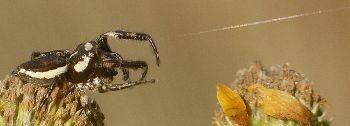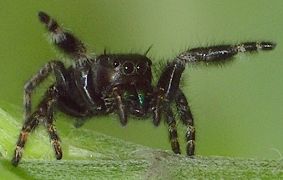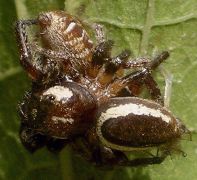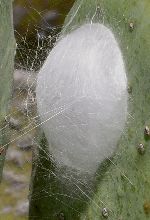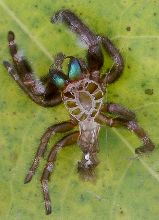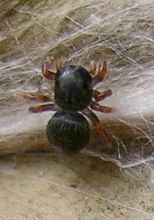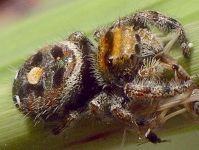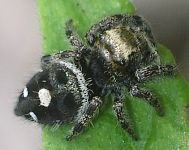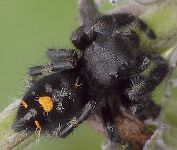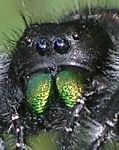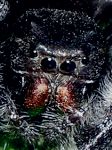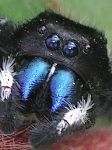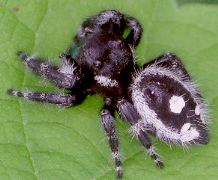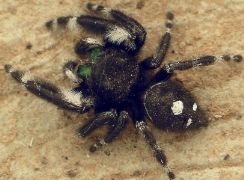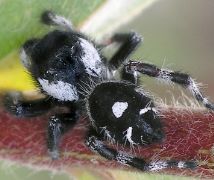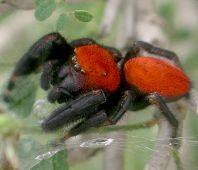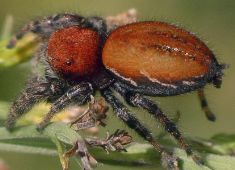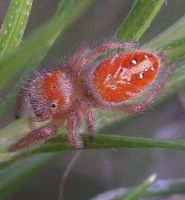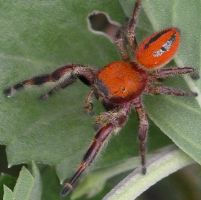
| Salticidae ~ Jumping Spiders |
|
The jumpers are perhaps the most easily recognized spider family. Some are so small that they are under the radar of the casual observer, but many are large enough to notice while not being big enough to intimidate the average person. In fact, for spiders, jumpers are rather cute, with compact, hairy bodies and relatively short legs. Their pair of large headlight-like eyes almost seem cartoonish, and they tend to react to our presence with more familiar behaviors than a lot of arthropods.
Although easy to identify to family, in many cases it is quite a bit harder to get to genus and species. Part of the problem is that the family is rather homogenous in appearance. With only a few exceptions, the description given above fits almost all species. However, as with most arthropod groups, it simply takes practice and diligent study to sort out most of the different kinds. One other aspect makes identification difficult and that is the way the abdomen expands and contracts depending on food intake and whether a female is pregnant or not. The variations can be dramatic and change the look of an individual quite a bit.
Jumping spiders do not make webs to snare food. They do use silk, but only for building retreats, protecting eggs, and creating safety lines while moving about. Their small size makes ballooning (the practice of sending out a strand of silk to catch the wind and carry the spider into the air) practical, and more than once I've seen my photo subject playing out a thin line that ends up heading straight for me in an unnoticed breeze. It is a bit alarming when the spider starts to cross its new tightrope in order to approach me (curiosity, perhaps?) and I almost always react with more thrashing than is warranted. The venom of jumping spiders is not considered to be dangerous to humans, but these species do subdue large prey without the use of webs, so their venom must be powerful enough for that. Many jumpers are too small to bite humans but bigger ones can give a prick equal to a bee sting if treated roughly.
With the excellent eyesight needed for active hunting, jumpers tend to notice everything around them, including both large and small beings. While they may sometimes be aggressive or curious, they more often react in fear at our approach, as we are large enough to pose a threat. When jumping spiders mate, they appear to be having a wrestling match. Males and females are usually close in size, unlike the huge differences found in some other spider families. The male is usually on top and grasps the female who is upside down and turned at an angle, but mostly has her rear towards his head. His job is to transfer sperm from his pedipalps (front appendages near the jaws that look like small legs) to an area located near the front end of the underside of her abdomen.
The most conspicuous genus of jumping spiders is Phidippus. These species are among our largest, reaching 15 mm in length, although most are around 10 mm long. They tend to be hairy and colorful. By far the most common species is the Bold Jumper (Phidippus audax). Often seen around flowers and in gardens, this is a large black spider with white markings. This species has earned its name and individuals are often very forward or curious (the species name derives from audacious), hunting all manner of prey and even leaping straight at camera lenses!
Because the species is so big, immature individuals are also frequently encountered. They are as large as the full grown adults of other kinds of jumpers. Young Bold Jumpers sometimes look quite different from the adults. At the earliest stages, they might have brown and gray markings that are much more ornate than the mature white and black. They also may be metallic, and this can occur with either mostly black colors or the brown and gray. Middle instars (stages of growth) usually turn black, but may retain the other colors for a bit. They also sometimes have red or orange spots on their abdomen where the white will be later.
The chelicerae, or fangs, are a metallic color that may be coppery, green or blue, and the amount of white markings on adults varies considerably, from just three white spots on the top of the abdomen and a bit of white on the legs to extensive white on the sides of the cephalothorax and the abdomen. The two genders have similar markings.
Our other Phidippus species are not nearly as common as the Bold Jumper. The Cardinal Jumper (Phidippus cardinalis) is one I see occasionally, and mostly because of its color. The females of this species are quite large, especially when they are well fed and gravid. The basic color scheme of red on top and black on the bottom is augmented on the females by tiny white dots on the abdomen. However, these are much more evident in young individuals than on mature adults. Females also sometimes have white slashes along their sides. Cardinal Jumpers are most often found in areas with tall grass and weeds, and they frequently climb up on the grass stems. The females seem to go for large prey, including grasshoppers and katydids several times bigger than they are.
One other red species that I've seen is Phidippus pius. However, I've only found one mature male and have not yet seen a female. This spider differs from P. cardinalis in having black marks on its abdomen and lighter color on the legs and underside. |
![]()
